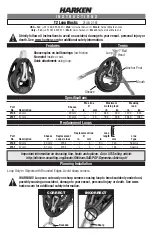
10
Joerns
®
Support Surfaces
DermaFloat
®
APM
Resident Positioning and Comfort
General Repositioning
Residents should be turned and repositioned per
individual turning schedule or per facility policy. It may
be helpful to activate the
Autofirm
mode to achieve
a firm surface for repositioning purposes. The unit
will automatically return to the mode it was in prior
to
Autofirm
in approximately 10 minutes or it can
manually be returned to therapy mode once resident
has been repositioned.
Unless contraindicated, it is desirable to keep the
head of the bed in the low position to provide optimal
pressure redistribution and minimize the risk of
shearing injuries.
Elevating Resident into Sitting Position
The special properties of the DermaFloat
®
APM,
therapy pad reduce the opportunity for shear and
friction that may occur when raising the head of other
beds. As with any surface, sliding can be expected;
therefore, residents should be repositioned after
elevation. The knee gatch or foot of the bed may be
elevated first, to help prevent the resident from sliding
when the head of the bed is elevated.
Incontinence
Moisture against the skin surface leads to maceration,
or softening of the tissues. To prevent maceration, we
recommend the use of an incontinence barrier pad to
absorb the excess moisture.
In the event of incontinence or excess drainage on the
therapy pad, excess fluid should be wiped off the bed
surface.
Safety Information
Resident Migration
Specialty bed products are designed to redistribute
pressure and the shearing/friction forces on the
resident’s skin. The risk of gradual movement and/or
sinking into hazardous positions of entrapment and/
or inadvertent bed exit may be increased due to the
nature of these products.
Traction
With any traction or unstable fractures, maintain
physician-directed angle of articulation and guard
against risks of resident migration or inadvertent
deflation of resident surface.
Skin Care
Monitor skin conditions regularly, particularly in areas
where incontinence and drainage occur or collect,
and consider adjunct or alternative therapies for high
acuity residents. Early intervention may be essential to
preventing serious skin breakdown.
Bed Height
To minimize the risks of falls or injury, the resident
surface should always be in the lowest practical
position when the resident is unattended. Make sure
areas under and around the frame are clear of objects,
persons and parts of body before adjusting height.
Cleaning
Warning:
Unplug the control unit from its power
source. Failure to do so could result in personal injury
or equipment damage.
Warning:
Do not expose the unit to excessive
moisture that would allow for liquid pooling. Personal
injury or equipment damage could occur.
Caution:
Do not use harsh cleansers/detergents, such
as scouring pads and heavy-duty grease removers, or
solvents, such as acetone. Equipment damage could
occur.
Control Unit
Wipe off dust. If necessary, clean the housing exterior
with a disinfectant solution or a mild detergent and a
damp cloth. Then wipe dry.
General Cleaning
If there is no visible soilage with possible body fluids,
we recommend that the mattress system be cleaned
with a mild detergent and warm water. If disinfection is
desired, a combination cleanser/disinfectant may be
used as explained in “Disinfecting” section.
• Resident care equipment that does not come in
contact with mucous membranes or non-contact skin
requires low-level disinfection. Wiping surfaces with
a properly prepared detergent or disinfectant carries
out low level disinfecting.
• Processing of dirty resident care equipment should
take place in a designated area away from clean or
sterile supplies and food preparation areas.
• Detergent/disinfectants should not be mixed with
other germicides or detergents. Using the proper
dilution ensures the most effective killing power of
the disinfectant.
• Wash hands often and well, including after removal
of gloves.
































